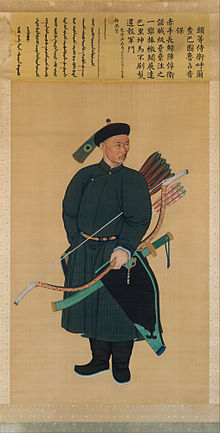Wu Quanyou(Chinese:Ngô toàn hữu;Wade–Giles:Wu Ch‘üan-yu;1834–1902) was an influential teacher of thetai chimartial art in late ImperialChina.His son is credited as the founder of theWu-style tai chi.[1]As he was ofManchudescent, and would have been named by his family in Manchu, the name "Wú" ( Ngô ) was a sinicisation that approximated the pronunciation of the first syllable of hisManchu clan name,U Hala.[2]
| Wu Quanyou | |
|---|---|
| Born | Ngô toàn hữu 1834 China |
| Died | 1902 (aged 67–68) |
| Nationality | Chinese |
| Style | Wu-style tai chi |
| Notable students | Wu Jianquan Wang Maozhai Guo Songting ( quách tùng đình ) Chang Yuanting ( thường xa đình ) Xia Gongfu ( hạ công phủ ) Qi Gechen ( tề các thần ) |
| Wu Quanyou | |||||||
|---|---|---|---|---|---|---|---|
| Traditional Chinese | NgôToànHữu | ||||||
| Simplified Chinese | NgôToànHữu | ||||||
| |||||||

Life
editWu Quanyou was a military officer in theYellow Bannercamp in theForbidden City,Beijingand also an officer of theImperial Guards Brigadeduring theQing dynasty.Wu wished to study underYang Luchan,the tai chi instructor for that banner camp, but he was still a middle grade officer and Yang refused to teach him.[1][2][3]Instead, Wu and two other officers, Wan Chun ( vạn xuân ) and Ling Shan ( lăng sơn ), were asked to become disciples ofYang Banhou,Yang Luchan's oldest adult son and also a tai chi instructor for the Qing military.[2]
When Wu retired from the military, he set up a school in Beijing. Wu's Beijing school was successful and there were many who studied with him, he was popularly known as Quan Sanye ( toàn tam gia ) as a term of respect. His disciples includedWang Maozhai,Guo Songting ( quách tùng đình ), Xia Gongfu ( hạ công phủ ), Chang Yuanting (1860-1918; thường xa đình ), Qi Gechen ( tề các thần ), and Wu's own son,Wu Jianquan(seeWudang tai chi lineage). Wu's skills were said to be exceptional in the area of softly "neutralising" (Hóa kính;huà jìn) hard energy when attacked, which is a core skill of good tai chi.[3]Chang Yuanting's son Chang Yunji taught a style known as "Quanyou laojiatai chi "( toàn hữu lão giá Thái Cực quyền ) or" Chang-style tai chi "( thường thị Thái Cực quyền ).[4]
Wu's son,Wu Jianquanalso became a cavalry officer and tai chi teacher, working closely with the Yang family andSun Lutang,promoting what subsequently came to be known as Wu-style tai chi inBeijing,Shanghai,andHong Kong.[1][5][6]
Tai chi lineage tree with Wu-style focus
editNote:
- This lineage tree is not comprehensive, but depicts those considered the 'gate-keepers' & most recognized individuals in each generation of Wu-style.
- Although many styles were passed down to respective descendants of the same family, the lineage focused on is that of the Wu style & not necessarily that of the family.
| Key: | NEIJIA | ||||||||||||||||||||||||||||||||||||||||||||||||||||||||||||||||||||||||||||
| Solid lines | Direct teacher-student. | ||||||||||||||||||||||||||||||||||||||||||||||||||||||||||||||||||||||||||||
| Dot lines | Partial influence /taught informally /limited time. | TAI CHI | |||||||||||||||||||||||||||||||||||||||||||||||||||||||||||||||||||||||||||
| Dash lines | Individual(s) omitted. | ||||||||||||||||||||||||||||||||||||||||||||||||||||||||||||||||||||||||||||
| Dash cross | Branch continues. | CHEN-STYLE | Zhaobao-style | ||||||||||||||||||||||||||||||||||||||||||||||||||||||||||||||||||||||||||
| YANG-STYLE | |||||||||||||||||||||||||||||||||||||||||||||||||||||||||||||||||||||||||||||
| ( vương lan đình ) Wang Lanting 1840–? 2nd gen. Yang | Yang Jianhou 1839–1917 2nd gen. Yang 2nd gen.Yangjia Michuan | Yang Banhou 1837–1892 2nd gen. Yang 2nd gen. Guang Ping Yang Yang Small Frame | WU (HAO)-STYLE | Zhaobao He-style | |||||||||||||||||||||||||||||||||||||||||||||||||||||||||||||||||||||||||
| Li-style | Yang Shao-hou 1862–1930 3rd gen. Yang Yang Small Frame | Wu Quanyou 1834–1902 1st gen. Wu | |||||||||||||||||||||||||||||||||||||||||||||||||||||||||||||||||||||||||||
| ( tề các thần ) Qi Gechen 2nd gen. Wu | ( hạ công phủ ) Xia Gongfu 2nd gen. Wu | Wu Jianquan 1870–1942 2nd gen. Wu WU-STYLE 108 Form | ( thường xa đình ) Chang Yuanting 1860–1918 2nd gen. Wu | ( quách tùng đình ) Guo Songting 2nd gen. Wu | Wang Maozhai 1862–1940 2nd gen. Wu | SUN-STYLE | |||||||||||||||||||||||||||||||||||||||||||||||||||||||||||||||||||||||
| Dong Yingjie 1891–1960 4th gen. Yang | ( tề mẫn hiên ) Qi Minxuan 3rd gen. Wu | Cheng Wing Kwong 1903–1967 3rd gen. Wu | Wu Yinghua 1907–1997 3rd gen. Wu | Wu Gongyi 1900–1970 3rd gen. Wu | Wu Kung-tsao 1903–1983 3rd gen. Wu | Ma Yueliang 1901–1998 3rd gen. Wu | Yang Yuting 1887–1982 3rd gen. Wu | ||||||||||||||||||||||||||||||||||||||||||||||||||||||||||||||||||||||
| ( Trịnh thiên hùng ) Cheng Tin Hung 1930–2005 Wudang-style | Wu Ta-k'uei 1923–1972 4th gen. Wu | Wu Yanxia 1930–2001 4th gen. Wu | Wu Daxin 1933–2005 4th gen. Wu | (Lập đàn) Li Liqun 1924–2013 4th gen. Wu | Wang Peisheng 1919–2004 4th gen. Wu | ||||||||||||||||||||||||||||||||||||||||||||||||||||||||||||||||||||||||
| Wu Kuang-yu 1946–Present 5th gen. Wu | ( Lạc thư hoán ) Luo Shuhuan 1935–1987 5th gen. Wu | ||||||||||||||||||||||||||||||||||||||||||||||||||||||||||||||||||||||||||||
| CHEN-STYLE | YANG-STYLE | WU-STYLE | SUN-STYLE | WU (HAO)-STYLE | |||||||||||||||||||||||||||||||||||||||||||||||||||||||||||||||||||||||||
See also
edit- Wu Yinghua
- Ma Yueliang
- Ma Jiangbao,son of Wu Yinghua and Ma Yueliang
- Wu Daqi
- Wu Daxin
References
edit- ^abcWile, Douglas (1995).Lost T'ai-chi Classics from the Late Ch'ing Dynasty (Chinese Philosophy and Culture).State University of New York Press.ISBN978-0-7914-2654-8.
- ^abcWu, Ying-hua (1988).Wu Style T'ai Chi Ch'uan – Forms, Concepts and Applications of the Original Style.Shanghai Book company, Ltd., Hong Kong.
- ^abWu, Kung-tsao (2006) [1980].Wu Family T'ai Chi Ch'uan ( Ngô gia Thái Cực quyền ).Chien-ch'uan T'ai-chi Ch'uan Association.ISBN0-9780499-0-X.
- ^Zhang, Tina (2006).Classical Northern Wu Style Tai Ji Quan.Berkeley, California: Blue Snake Books.ISBN978-1-58394-154-6.
- ^Yip, Y. L. (Autumn 2002). "Pivot".Qi: The Journal of Traditional Eastern Health and Fitness.12(3). Insight Graphics Publishers.ISSN1056-4004.
- ^Philip-Simpson, Margaret (June 1995). "A Look at Wu Style Teaching Methods".T'AI CHI the International Magazine of T'ai Chi Ch'uan.19(3). Wayfarer Publications.ISSN0730-1049.
External links
edit- International Wu Style Tai Chi Chuan Federationat wustyle Wu family website with a link to a biography of Wu Quanyou (listed as "Wu Chuan Yau" )